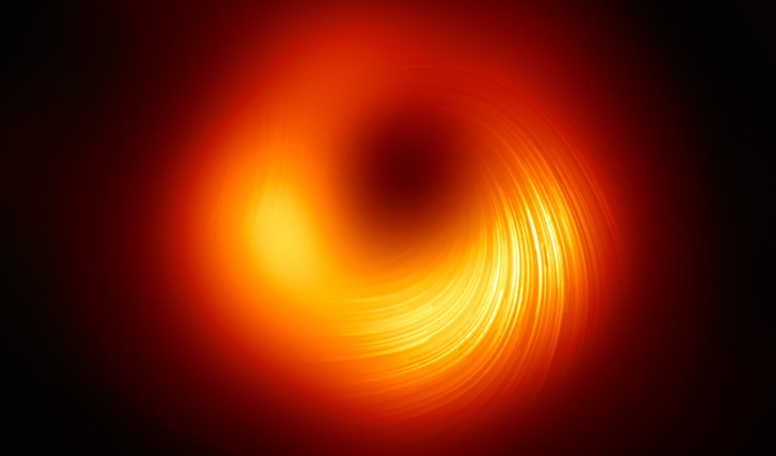Researchers behind the first ever image of a black hole taken by an Earth-sized virtual telescope, have now revealed an image showing magnetic field lines around the same enormous object, M87; this is the first time astronomers have been able to measure this phenomena this close to the edge of a black hole.
Nearly two years ago, scientists stunned the world, when in a series of simultaneous press conferences held around the globe, gave humanity its first view of a black hole.
It was the culmination of nearly two years of work by 200 international scientists from numerous institutions, who spent hundreds if not thousands of hours between them putting together data to produce the image.
The data was collected from the Event Horizon Telescope (EHT) – a huge virtual telescope which links together existing facilities such as the Atacama Large millimetre/submillimetre Array (ALMA), the Greenland Telescope (GLT) and the South Pole Telescope (SPT), to name just a few, to create a fundamentally new instrument with the highest angular resolving power that has yet been achieved.
Just how impressive is the resolution obtained with the EHT? It is the equivalent to that needed to measure the length of a credit card on the surface of the Moon.
Since then, scientists in the same collaboration, which has now grown to more than 300 members, have been using the EHT to measure polarised light around M87.
Why study polarised light? All common sources of light, including the Sun, incandescent and fluorescent lights and flames produce unpolarised light; unpolarised light refers to a light wave that is vibrating in more than one plane, whereas polarised light is a light wave where the vibrations occur in a single plane.
For some applications, such as image production, polarised light is better as it helps to see objects more clearly. For example, humans use filters on sunglasses to turn unpolarised light into polarised light, to reduce reflections and glare from bright surfaces.
In much the same way, black holes also act like natural filters as they polarise light when it passes through magnetic fields surrounding these huge objects.
This action of polarising light not only allows astronomers to sharpen their view of these regions, it also enables them to map the magnetic field lines at the inner edge of a black hole - a double bonus for those studying objects that are very difficult to see.
“This work is a major milestone: the polarisation of light carries information that allows us to better understand the physics behind the image we saw in April 2019, which was not possible before,” explains Iván Martí-Vidal, also Coordinator of the EHT Polarimetry Working Group and GenT Distinguished Researcher at the University of Valencia, Spain. He adds that “unveiling this new polarised-light image required years of work due to the complex techniques involved in obtaining and analysing the data.”
The result will also help the team better understand how this behemoth black hole is able to launch energetic jets from its core that extend at least 5000 light-years from its centre.
It is currently thought that the magnetic field funnels in matter lying close to the edge of the black hole, allowing it to 'eat' this dusty and gaseous material.
However, some of the surrounding particles escape moments before capture and are blown far out into space in the form of jets and astronomers do not know exactly where this interplay between matter flowing in and being ejected out is happening.
With the new EHT image of the black hole and its shadow in polarised light, the team have been able to narrow down this process to show how jets larger than the galaxy are launched from its central region.
“We are now seeing the next crucial piece of evidence to understand how magnetic fields behave around black holes, and how activity in this very compact region of space can drive powerful jets that extend far beyond the galaxy,” says Monika Mościbrodzka, Coordinator of the EHT Polarimetry Working Group and Assistant Professor at Radboud University in the Netherlands.
The team found that only theoretical models featuring strongly magnetised gas can explain what they are seeing at the event horizon.
“The observations suggest that the magnetic fields at the black hole’s edge are strong enough to push back on the hot gas and help it resist gravity’s pull. Only the gas that slips through the field can spiral inwards to the event horizon,” explains Jason Dexter, Assistant Professor at the University of Colorado Boulder, US, and Coordinator of the EHT Theory Working Group.
The team plan on completing further observations of M87 using the EHT to reveal its magnetic field structure with more accuracy and to help elucidate the underlying physics in the hot gas in this region, says EHT collaboration member Jongho Park, an East Asian Core Observatories Association Fellow at the Academia Sinica Institute of Astronomy and Astrophysics in Taipei.
This research was presented in two papers by the EHT collaboration published today in The Astrophysical Journal Letters.











